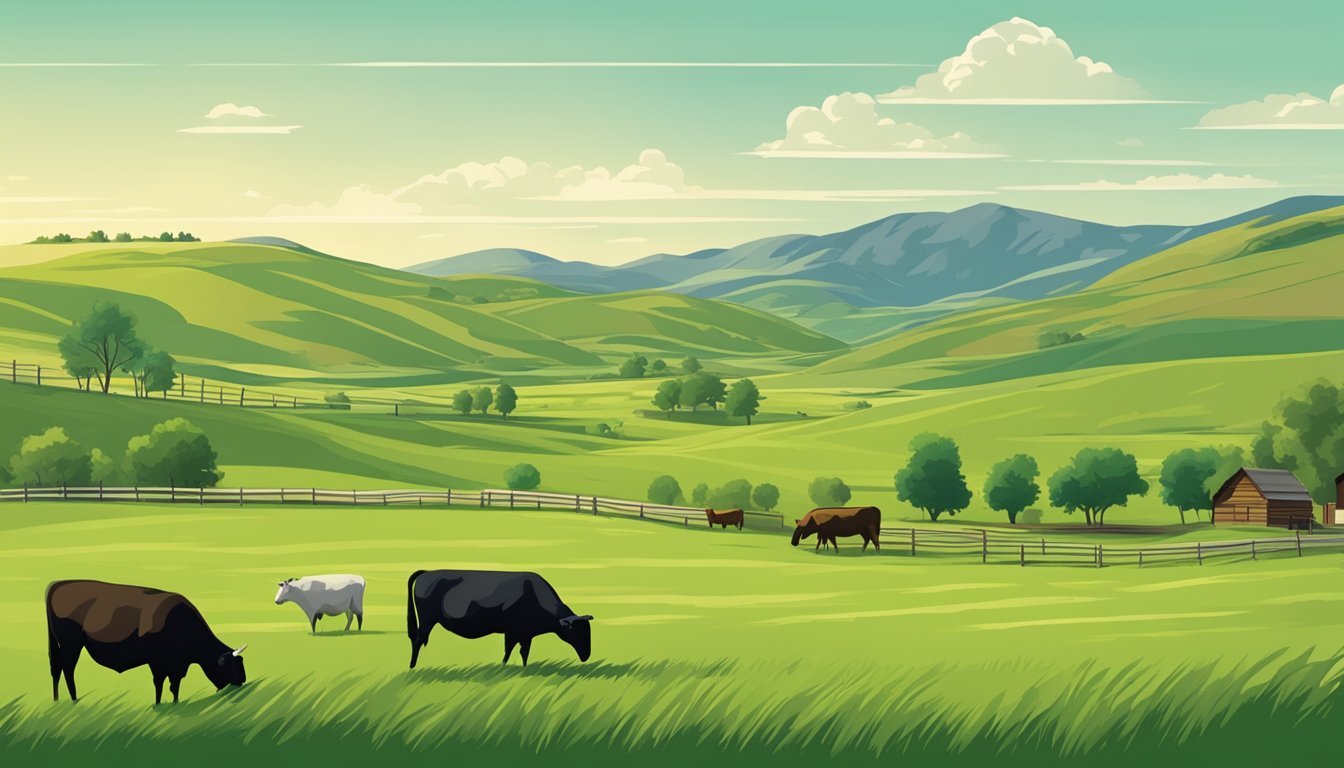Wyoming Farm Land for Lease
Opportunities for Growth and Investment
This Article is Part of Our Guide on Navigating Agricultural Leases Across the US
Wyoming, known for its vast plains and mountainous regions, offers a unique opportunity for those interested in leasing farmland. The state's agricultural sector is a fundamental pillar of its economy, with a substantial portion of land dedicated to farming and ranching. Engaging in farm leasing in Wyoming allows individuals and businesses alike to utilize the state's fertile land without the financial commitment of purchasing.
The availability of farmland for lease in Wyoming spans across various counties, including hotspots like Laramie, Uinta, and Carbon County. These areas are characterized by open spaces suitable for a range of agricultural activities from crop cultivation to livestock grazing. With a selection of different acreages on offer, potential lessees can find parcels that cater to their specific farming needs.
State regulations and the availability of resources such as water rights also play a critical role in agricultural leasing in Wyoming. Lessees typically seek land with the necessary provisions to support their intended farming operations. In addition to the leased land, some agreements may include access to state or BLM lease acres, which can expand the operational space for farming activities. As a prospective lessee, understanding the leasing terms and any additional benefits included is crucial in making an informed decision about engaging in Wyoming's agricultural leasing market.
Understanding Land Leases in Wyoming
Leasing land in Wyoming involves a variety of lease types and key terms. Land values and lease rates can vary, with state policies influencing agreements. Interactive resources aid in understanding these dynamics.
Types of Leases
Wyoming offers several lease types, including Special Use Leases for temporary projects and Agricultural Leases for farming or ranching. Grazing leases cater to livestock, while Commercial Leases serve business purposes.
Key Terminology
Leases involve Lessees (the renters) and Lessors (the landowners). Easements grant the right to use land for specific purposes. Understanding these terms is foundational.
Lease Rates and Deal Alerts
Rates hinge on land quality and usage; they may be quoted as $ per acre. The Board of Land Commissioners provides rate guidance. Wyoming's Deal Alert Program notifies of leasing opportunities.
State Regulations
State leases, managed by the Board of Land Commissioners, require adherence to strict regulations to protect land use. Private leases offer more flexibility. Regulations influence minimum acreage and financial terms.
Market Averages and Land Value
The land's value is impacted by its potential for agriculture, grazing, or commercial use. Market averages provide benchmarks for lease rates. The value determines the minimum and maximum lease payments.
Interactive Resources
The Land and Lease Map Viewer is an excellent tool for data-driven insights into Wyoming land for lease. It shows available parcels and their conditions, fostering an informed leasing process.
State vs. Private Leasing Differences
State leases are often more regulated and may require bidding through public auctions. Private leases may be negotiated directly between parties. Both can offer owner financing options.
Available Land Criteria
Criteria for land availability include zoning type, land condition, and intended use. Landcashin Marketplace is one among many platforms listing available lands, highlighting criteria for potential lessees.
Minimum Acreage Requirements
State and private leases may stipulate different Min Acres for lease. Agricultural activities typically require larger tracts, while Special Use Leases may require less.
Financial Considerations
Financial aspects of leasing include upfront costs, ongoing lease rates, and potential for owner finance opportunities. Lessees must also consider the / Ac Min and / Ac Max rates when budgeting.
Searching for Wyoming Farm Land for Lease
When searching for farm land to lease in Wyoming, it's important to navigate through various sources offering detailed information about available properties, understand the specific terms of lease ads, and be aware of factors that can affect lease availability. The process requires attention to details such as acreage, lease type, and location.
Step-by-Step Guide
Define Criteria: Start by determining the essential criteria for your desired property, including min acres, type of land (commercial farming or grazing), and the rent budget.
Research Online: Utilize online platforms like LandSearch and LandWatch to find listings that fit your criteria within different counties of Wyoming.
Contact Sellers: Reach out to property owners or agents listed on the platforms to get more details or to set up viewings.
Navigating Wyoming's Map Viewer
The Map Viewer provided by the state surface land management agencies can be used to gain insights into specific land properties in Wyoming. Use it to examine the county breakdown of available leases.
Understanding Lease Ads
Lease ads provide essential information such as rent prices, type of lease (commercial or grazing), and status (active, pending, or foreclosed). Scrutinize the ads for details about land property, including any residence on the property.
Potential Deal Breakers
Consider these potential deal breakers:
Foreclosed properties may come with legal complications.
Incorrect type of land lease for your intended use (e.g., commercial farming versus grazing).
Prohibitive rent or restrictive lease terms.
Setting Up Alerts for New Listings
Take advantage of deal alert programs to receive notifications about new listings. This ensures you don't miss out on newly available properties fitting your established criteria.
Factors Affecting Lease Availability
Lease availability in Wyoming can be influenced by local agricultural demand, seasonal variations, average property prices, and state-specific regulations regarding land use.
Commercial Farming vs. Grazing Leases
Commercial farming leases often require larger acreage and infrastructure compared to typical grazing leases. Understanding this distinction can help streamline your search to properties that cater to specific agricultural needs.
Financial Aspects of Leasing Farm Land
When leasing farm land in Wyoming, tenants and landowners must understand the financial intricacies, such as how lease rates are determined and what lease agreements entail to prevent misunderstandings and ensure mutual benefit.
Lease Rate Calculations
Lease rates for agricultural land can vary based on several factors, including the land's productivity, location, and the prevailing market conditions. Rates typically are established per acre and can be influenced by the minimum (Ac Min) and maximum (Ac Max) acreage available for lease. In Wyoming, for instance, rates might fluctuate around $197 per acre, though this figure can vary substantially based on specific circumstances. The method for calculating rates should be agreed upon by both parties to reflect the fair market value and can be influenced by:
Owner finance options, affecting the overall lease costs
Local benchmarks for rent in the agricultural sector
Specific lease terms regarding land use (Lease agreements)
It is critical for parties to conduct due diligence to ascertain accurate valuations of the agricultural land in question.
Understanding Lease Agreements
Lease agreements serve as the legal foundation for the arrangement between the landowner and lessee. They delineate terms that cover:
Duration: How long the lease agreement is valid.
Payment Structure: How and when payments are to be made.
Use of Land: What agricultural activities are permitted on the land.
Maintenance Responsibilities: Which party is responsible for land upkeep and improvements.
Lease agreements should be crafted with clarity to avoid any ambiguity regarding financial obligations and the rights and responsibilities of each party. Tenants and landowners are encouraged to consult with legal experts to ensure the lease is comprehensive and adheres to state regulations. Proper understanding and negotiation of lease agreements help maintain a stable relationship between lessee and landlord, ultimately contributing to the success of agricultural operations.
Legal and Regulatory Framework
In the state of Wyoming, the leasing of farm land is subject to a comprehensive legal and regulatory framework that ensures orderly use and management. Central to this framework is the role of the Board of Land Commissioners and the compliance with state laws and regulations related to land lease agreements.
Land Lease Agreements
A Land Lease Agreement in Wyoming is a binding contract between the lessor, often the state, and the lessee. It stipulates the terms and conditions under which the lessee can use the land, typically for agricultural and grazing purposes. These agreements contain essential elements such as:
Duration of lease: Defining the length of the lease term.
Lease payment terms: Outlining the fees and schedule for payments.
Use of land: Specifying the allowed uses such as agriculture, grazing, or others.
The process of leasing state-owned land requires the submission of an application alongside a filing fee, which varies based on the intended use and size of the land. Payment can be made through several methods including check or money order.
State Regulations and Compliance
The Board of Land Commissioners is the governing entity responsible for managing state lands, which includes overseeing leasing activities. They set forth rules that ensure:
Sustainable land use
Stewardship of natural resources
Compliance with these regulations is mandatory for lessees. The board's authority arises from Wyoming Statute (W.S. 36-2-107), and it defines critical terms such as "AUM" (animal-unit-month), which is the quantity of forage necessary to sustain one cow and one calf for one month.
Lessees must adhere to the easements that may be in place, which are legal rights to use the land for specific purposes. Complying with both the board's regulations and the terms of any easements is required to maintain the lease and avoid penalties.
Leveraging Technology in Land Leasing
In the sphere of land leasing in Wyoming, technological advancements are streamlining the process, making data more accessible and transactions more efficient.
Digital Tools and Platforms
Digital platforms such as Landcashin Marketplace provide a centralized location for buyers and sellers of Wyoming farm land leases to connect. These marketplaces offer detailed listings that often include photos, land features, and pricing, facilitating a smoother transaction process.
Furthermore, Land and Lease Map Viewers integrate geographic information systems (GIS) technology to aid in the visualization of land parcels. These tools allow users to see the layout of properties, boundaries, and topography, making it easier to assess land suitability for agricultural purposes.
Data plays a crucial role in the modern leasing landscape, offering insights into soil quality, historical land use, and crop yield estimates. This information empowers lessees and lessors to make informed decisions about farm land potential and value.
Tables and lists are also employed to organize and convey information effectively. A lessee might encounter a format like the following:
Land ID Size (Acres) Lease Type Starting Bid WY123456 150 Grazing Lease $2,500 WY654321 200 Agricultural $3,000
Utilizing these technological resources, stakeholders in Wyoming's agricultural leasing market can negotiate with greater precision and confidence, backed by robust data and user-friendly digital interfaces.
Comparative Analysis of Land Leasing by State
Land leasing practices vary significantly across the United States, with each state offering distinct opportunities and regulations that impact leasing processes. This section evaluates how Wyoming compares to other states in terms of land leasing policies and opportunities.
State-by-State Lease Comparisons
Wyoming stands out for its specific offerings of grazing and agricultural leases, as managed by the Office of State Lands and Investments. Here, one may lease land for purposes such as grazing livestock, raising crops, and other agricultural uses, with the rules governed by the Board of Land Commissioners. In comparison, leasing land in states like Colorado (CO) and Oregon (OR) may come with different regulations or focuses, such as recreation or conservation priorities.
In North Carolina (NC) and Alabama (AL), agricultural land leases are common but can also include provisions for timber production given the states' significant forest resources. Missouri (MO) and Iowa (IA), with their vast fertile lands, have a greater emphasis on crop production leases.
California (CA), known for its diverse agriculture, has a wider variety of lease types due to its range of climates, including vineyard and specialty crop leasing. Conversely, in Florida (FL), land leases may often center around citrus groves and sugar cane, reflecting the state's agricultural strengths.
In the Midwest, states like Nebraska (NE) and Kansas (KS) typically offer expansive land for row crops and livestock grazing, while in South Dakota (SD), there is a unique market for hunting land leases due to its abundant wildlife.
Northeastern states such as Massachusetts (MA) and Connecticut (CT), where agricultural land is more limited, often have higher lease rates and might focus on niche markets like organic farming or agri-tourism.
Meanwhile, in Texas (TX), there is a significant market for both agricultural and oil and gas land leases, reflecting the state's economic diversity. This stands in contrast to smaller states like Delaware (DE) and Rhode Island (RI), where land is at a premium and leases may be less agriculture-focused.
The leasing landscape in Arizona (AZ) and New Mexico (NM) typically includes considerations for both farming and ranching, influenced by arid climates and tribal land management practices.
Pennsylvania (PA) and New York (NY) have a mix of farming leases that often include dairy operations, which differ from southern states like Georgia (GA) and South Carolina (SC), where leases might emphasize crops such as peaches and cotton.
Overall, while the state of Wyoming provides opportunities primarily in grazing and agriculture, other states offer a diverse array of leasing options reflecting their unique geographies, climates, and agricultural industries.
Conclusion
Wyoming presents varied opportunities for individuals and businesses looking to lease farm land. Leases come with different terms, often dictated by the nature of the agricultural project and the agreement between the landowner and lessee. Typically, lease durations can span from a single season to multiple years.
Key Points:
Lease Purpose: Primarily for livestock grazing, crop production, or other agricultural uses.
Duration: Ranges from short-term to long-term based on mutual agreements.
Legal Requirements: Governed by state regulations to ensure fair dealings and proper land use.
Wyoming's vast landscapes support a diverse range of agricultural activities, with some regions more suitable for grazing and others for crops. Interested parties should understand relevant local regulations outlined in the Board of Land Commissioners' rules to ensure compliance.
Contacts and Bids: For information on current leasing options, one can refer to Wyoming's Grazing & Agricultural Lease Contacts.
Rates: Farmland rental rates have demonstrated a trend, increasing over the past two decades. However, current rates are variable and subject to change based on market conditions.
Prospective lessees are advised to conduct thorough research and possibly seek legal counsel before entering into any lease agreements to ensure all aspects of the contract are clear and beneficial.
Considerations Before Leasing:
Suitability of land for intended agricultural use.
Historical rental rates and trends.
Inspection protocols and rights.
Lease termination procedures and penalties, if any.
Those with an interest in leasing farm land in Wyoming should approach the transaction with diligence, ensuring that the land meets their agricultural needs and that the lease reflects fair terms.
Relevant Entities
When exploring farm land leasing options in Wyoming, a variety of entities across the United States come into play. These vary from state departments and divisions that manage such leases to neighboring states that may have stakeholders or influence in agricultural land management.
State Departments:
The Wyoming Office of State Lands and Investments is integral for offering leases, as well as for maintaining a Land and Lease Map Viewer for potential lessees.
Agricultural Leasing Departments in Wyoming offer contact points for inquiries, exemplified by personnel like Tori Thacker and Patrick Bonine, who oversee Grazing & Agricultural Leases.
It is significant to consider neighboring states such as Colorado (CO), Utah (UT), Nebraska (NE), and South Dakota (SD), which may share similar agricultural practices and cross-state leasing opportunities.
Out-of-State Interest: Entities in California (CA), Florida (FL), and New York (NY), often representing larger agricultural corporations or investment groups, show interest in leasing farm land for diverse agricultural ventures.
Resource Management:
Neighboring Nevada (NV) has entities managing significant land acreages, potentially influencing market rates and leasing terms.
Arizona (AZ) stands as a reference point for annual lease pricing, providing a comparative framework for Wyoming's land lease market.
Entities in states with rigorous land management laws, such as Oregon (OR) and Washington (WA), can inform Wyoming's regulations and best practices in farmland leasing.
The interaction between these entities, across different states, establishes a complex network crucial to understanding the dynamics of leasing agricultural land in Wyoming.










